Caveolae provide a specialized membrane environment for respiratory syncytial virus assembly
- PMID: 28154158
- PMCID: PMC5358342
- DOI: 10.1242/jcs.198853
Caveolae provide a specialized membrane environment for respiratory syncytial virus assembly
Abstract
Respiratory syncytial virus (RSV) is an enveloped virus that assembles into filamentous virus particles on the surface of infected cells. Morphogenesis of RSV is dependent upon cholesterol-rich (lipid raft) membrane microdomains, but the specific role of individual raft molecules in RSV assembly is not well defined. Here, we show that RSV morphogenesis occurs within caveolar membranes and that both caveolin-1 and cavin-1 (also known as PTRF), the two major structural and functional components of caveolae, are actively recruited to and incorporated into the RSV envelope. The recruitment of caveolae occurred just prior to the initiation of RSV filament assembly, and was dependent upon an intact actin network as well as a direct physical interaction between caveolin-1 and the viral G protein. Moreover, cavin-1 protein levels were significantly increased in RSV-infected cells, leading to a virus-induced change in the stoichiometry and biophysical properties of the caveolar coat complex. Our data indicate that RSV exploits caveolae for its assembly, and we propose that the incorporation of caveolae into the virus contributes to defining the biological properties of the RSV envelope.
Keywords: Caveolae; Caveolin; Cavin; Respiratory syncytial virus; Virus assembly; Virus envelope.
© 2017. Published by The Company of Biologists Ltd.
Conflict of interest statement
The authors declare no competing or financial interests.
Figures
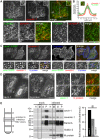
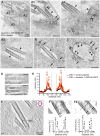
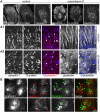
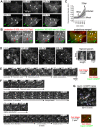
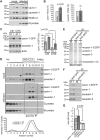



Similar articles
-
A critical phenylalanine residue in the respiratory syncytial virus fusion protein cytoplasmic tail mediates assembly of internal viral proteins into viral filaments and particles.mBio. 2012 Feb 7;3(1):e00270-11. doi: 10.1128/mBio.00270-11. Print 2012. mBio. 2012. PMID: 22318318 Free PMC article.
-
Defining the Assembleome of the Respiratory Syncytial Virus.Subcell Biochem. 2023;106:227-249. doi: 10.1007/978-3-031-40086-5_9. Subcell Biochem. 2023. PMID: 38159230 Review.
-
Caveolin-1 is incorporated into mature respiratory syncytial virus particles during virus assembly on the surface of virus-infected cells.J Gen Virol. 2002 Mar;83(Pt 3):611-621. doi: 10.1099/0022-1317-83-3-611. J Gen Virol. 2002. PMID: 11842256
-
PTRF-Cavin, a conserved cytoplasmic protein required for caveola formation and function.Cell. 2008 Jan 11;132(1):113-24. doi: 10.1016/j.cell.2007.11.042. Cell. 2008. PMID: 18191225 Free PMC article.
-
The link between respiratory syncytial virus (RSV) morphogenesis and virus transmission: Towards a paradigm for understanding RSV transmission in the upper airway.Virology. 2025 Mar;604:110413. doi: 10.1016/j.virol.2025.110413. Epub 2025 Jan 22. Virology. 2025. PMID: 39869971 Review.
Cited by
-
Caveolin-1 is involved in encephalomyocarditis virus replication in BHK-21 cells.Virol J. 2021 Mar 24;18(1):63. doi: 10.1186/s12985-021-01521-3. Virol J. 2021. PMID: 33761945 Free PMC article.
-
Mapping the SARS-CoV-2-Host Protein-Protein Interactome by Affinity Purification Mass Spectrometry and Proximity-Dependent Biotin Labeling: A Rational and Straightforward Route to Discover Host-Directed Anti-SARS-CoV-2 Therapeutics.Int J Mol Sci. 2021 Jan 7;22(2):532. doi: 10.3390/ijms22020532. Int J Mol Sci. 2021. PMID: 33430309 Free PMC article. Review.
-
Time-resolved proximity proteomics uncovers a membrane tension-sensitive caveolin-1 interactome at the rear of migrating cells.Elife. 2024 Sep 24;13:e85601. doi: 10.7554/eLife.85601. Elife. 2024. PMID: 39315773 Free PMC article.
-
Xuanfei Formula inhibited RSV infection by normalizing the SREBP2-mediated cholesterol synthesis process.Front Microbiol. 2024 May 2;15:1387062. doi: 10.3389/fmicb.2024.1387062. eCollection 2024. Front Microbiol. 2024. PMID: 38765687 Free PMC article.
-
Salidroside Attenuates LPS-Induced Acute Lung Injury in Rats.Inflammation. 2017 Oct;40(5):1520-1531. doi: 10.1007/s10753-017-0593-6. Inflammation. 2017. PMID: 28526985
References
-
- Ariotti N., Fernández-Rojo M. A., Zhou Y., Hill M. M., Rodkey T. L., Inder K. L., Tanner L. B., Wenk M. R., Hancock J. F. and Parton R. G. (2014). Caveolae regulate the nanoscale organization of the plasma membrane to remotely control Ras signaling. J. Cell Biol. 204, 777-792. 10.1083/jcb.201307055 - DOI - PMC - PubMed
MeSH terms
Substances
LinkOut - more resources
Full Text Sources
Other Literature Sources

